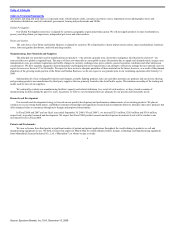Rayovac 2008 Annual Report Download - page 21
Download and view the complete annual report
Please find page 21 of the 2008 Rayovac annual report below. You can navigate through the pages in the report by either clicking on the pages listed below, or by using the keyword search tool below to find specific information within the annual report.
Table of Contents
Index to Financial Statements
• enter into or engage in transactions with affiliates; or
• merge, consolidate or sell all or substantially all of our assets.
In addition, both the Senior Credit Agreement, as defined in “Management’s Discussion and Analysis of Financial Condition and Results of
Operations—Debt Financing Activities,” and the indentures governing the Senior Subordinated Notes contain covenants which require us to meet a number of
financial ratios and tests. Noncompliance with these covenants could materially and adversely affect our ability to finance our operations or capital needs and to
engage in other business activities that may be in our best interest and may also restrict our ability to expand or pursue our business strategies. We may not be
able to comply with all of our covenants and obligations in all our debt instruments.
We face risks related to the current economic crisis.
The continued credit crisis and related turmoil in the global financial system has had and may continue to have an impact on our business and our financial
condition. Global economic conditions have significantly impacted economic markets generally with certain sectors, including financial industries and retail
business being particularly impacted. Our ability to generate revenue, in particular from sales of our home and garden products, pet supplies, electric shaving and
grooming and electric personal care products, depends significantly on discretionary consumer spending. It is difficult to predict new general economic
conditions that could impact consumer and customer demand for our products or our ability to manage normal commercial relationships with our customers,
suppliers and creditors. The recent emergence of a number of negative economic factors, including heightened investor concerns about the credit quality of
mortgages, constraints on the supply of credit to households, continuing increases in energy prices, lower equity prices, softening home values, uncertainty and
perceived weakness in the labor market and general consumer fears of a recession or depression could have a negative impact on discretionary consumer
spending in Fiscal 2009 and beyond. If the current situation deteriorates significantly, our business could be negatively impacted, including as a result of reduced
demand for our products or supplier or customer disruptions. Any significant decrease in discretionary consumer spending could have a material adverse effect
on our revenues, results of operations and financial condition. In addition, our ability to access the capital markets may be severely restricted at a time when we
would like, or need, to do so, which could have an impact on our flexibility to react to changing economic and business conditions. Further, if lenders under our
$225 million asset-based credit facility become unwilling or unable to fund their respective commitments, we may have reduced availability under the facility.
We may not be able to maintain our listing with the New York Stock Exchange.
On November 4, 2008, the Company received written notice from the New York Stock Exchange, Inc. (the “NYSE”) that the Company had fallen below
the NYSE’s continued listing standard set forth in Section 802.01B of the NYSE Listed Company Manual because over a 30 trading-day period the Company’s
total market capitalization was less than $75 million and, at the same time, its stockholders’ equity was less than $75 million. In addition, on November 20, 2008,
the Company received written notice from the NYSE that the average 30 trading-day closing price of the Company’s common stock had fallen below $1.00 in
violation of the NYSE’s continued listing standards set forth in Section 802.01C of the NYSE Listed Company Manual. There can be no assurances that the
Company will be able to maintain its listing. Based on conversations with the NYSE, we expect to receive notice of a determination that trading of our common
stock on the NYSE should be suspended. Continued non-compliance with the NYSE’s continued listing standards or delisting from the NYSE could negatively
impact the Company, including, without limitation, with respect to the Company’s relationships with customers and suppliers and access to equity financing,
which in turn could materially and adversely affect our business, financial condition and results of operations.
Securities traded in the over-the-counter market generally have significantly less liquidity than securities traded on a national securities exchange, through
factors such as a reduction in the number of investors that will consider investing in the securities, the number of market makers in the securities, reduction in
securities analyst and news media coverage and lower market prices than might otherwise be obtained. As a result, in the event of a delisting, holders of shares of
our Common Stock may find it difficult to resell their shares at prices quoted in the
16
Source: Spectrum Brands, Inc, 10-K, December 10, 2008
























